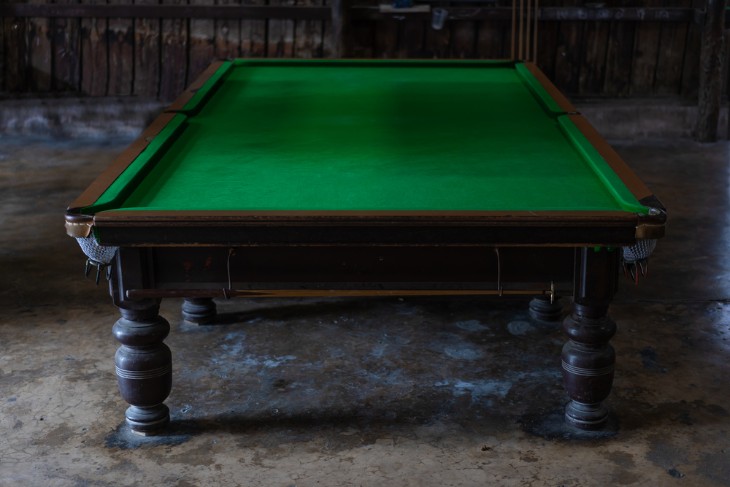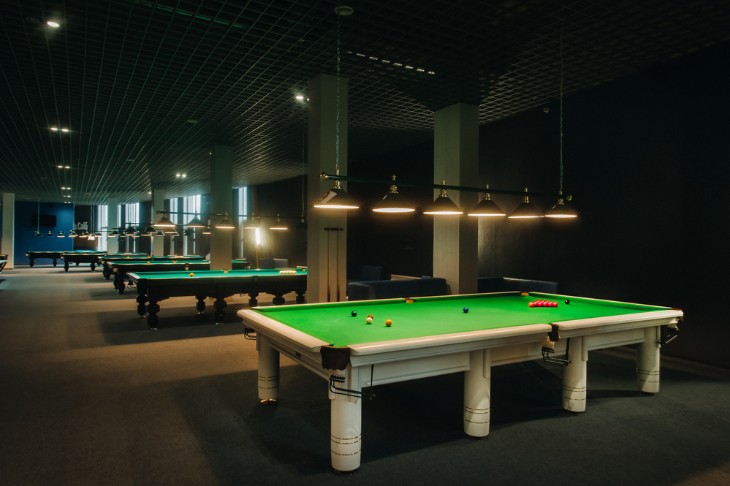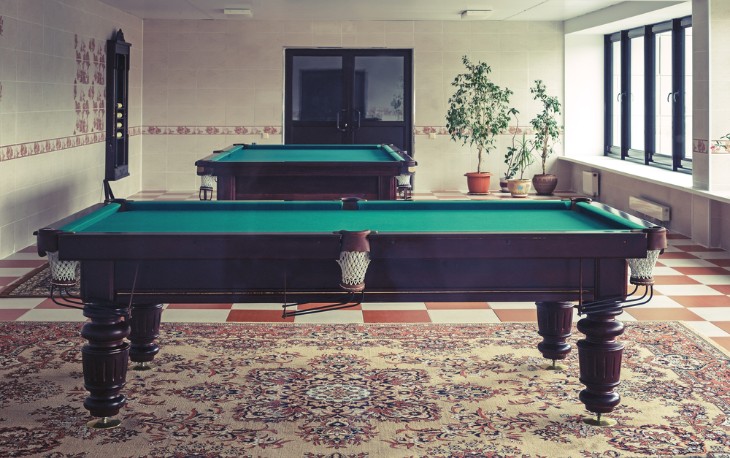In this article, we focus on the snooker table's height, highlighting how this aspect profoundly affects game outcomes. The height is not just a physical feature but a critical element that contributes to the unique nature of snooker, affecting every shot and strategy employed by the players.
Snooker Table Dimensions
A standard snooker table is a rectangular playing surface with specific measurements that are fundamental to the game's integrity. The length of a standard snooker table is typically 12 feet (365.76 cm), while its width measures half of its length, making it 6 feet (182.88 cm) wide. This precise ratio provides players with an optimal playing area, ensuring that the game's nuances and challenges are consistent across different matches and venues. The uniformity in table dimensions is vital in maintaining fairness and skill-based competition in the world of snooker.
The cloth covering, often referred to as felt, is a critical component of a snooker table. Traditionally made from wool, the cloth is tightly stretched and glued to the slate surface, providing a smooth and consistent playing field. The quality of the cloth significantly impacts the gameplay, as it affects the speed, spin, and overall control of the balls. High-quality snooker tables use a nap cloth, where the fibres lie in a specific direction to enhance playability. The colour of the cloth is predominantly green, a hue chosen for its contrast with the colourful snooker balls, making it easier for players and spectators to follow the game.
Snooker tables have six pockets, one at each corner and one in the middle of each longer side. The pockets are designed to be both challenging and fair, requiring players to demonstrate precision and skill when potting balls. The pockets have a standardized size, with a width ranging from 2.25 inches (5.715 cm) to 2.875 inches (7.3025 cm). These dimensions ensure that the balls do not easily fall into the pockets, demanding players to carefully calculate their shots and angles. The placement of the pockets is strategic, contributing to the tactical aspects of the game. The corner pockets are narrower than the middle pockets, adding an extra layer of complexity to the game as players aim to pot balls accurately and avoid scratching the cue ball.
Height of a Snooker Table
So, how high is a snooker table? The height of a snooker table from the floor is a crucial element that significantly influences the gameplay experience. A standard snooker table is set at a height of 2 feet 9.5 inches (85.09 cm) from the ground to the top surface of the playing area. This specific height is meticulously maintained to ensure consistency across all competitive matches and recreational games. The level at which the table is set plays a pivotal role in the ergonomics of the game, allowing players to maintain a comfortable stance and execute shots with precision.
Why the Table's Height is Crucial for Gameplay
Player Comfort and Posture: The standard height ensures that players can maintain a natural and comfortable posture while playing. This is essential for extended periods of gameplay, allowing players to focus on their shots without discomfort.
Consistency in Shots: A uniform table height ensures that the angle and trajectory of shots remain consistent across different games and venues. This consistency is essential for players to develop their skills and strategies, as they can rely on the table's height being the same wherever they play.
Challenge and Precision: The height of the table adds an element of challenge to the game. Players must gauge the distance between the cue ball and the target ball accurately, taking into account the table's height, to execute precise shots. This challenge tests a player's skill and adds depth to the gameplay.

Standard Height Measurements
In professional and competitive settings, adherence to standard height measurements is strictly enforced by governing bodies such as the World Professional Billiards and Snooker Association (WPBSA). These organizations ensure that snooker tables used in tournaments conform to the specified height requirements, maintaining a level playing field for all participants. Additionally, recreational players and enthusiasts often opt for tables designed to the same standard measurements, allowing them to practice and enjoy the game in a manner consistent with professional standards.
Table Construction
Snooker tables are crafted using a combination of high-quality materials to ensure durability, stability, and optimal playing conditions. The key components of a snooker table include:
- Slate: The playing surface of a snooker table is typically made from slabs of slate, a dense and smooth rock that provides an excellent, consistent surface for gameplay. High-end snooker tables often use multiple pieces of slate, precisely joined and levelled to eliminate any imperfections in the playing surface.
- Wood: The frame and legs of a snooker table are usually made from sturdy and durable hardwoods such as oak, mahogany, or maple. These woods are chosen for their strength, stability, and resistance to warping over time.
- Cloth: As mentioned earlier, the cloth covering the playing surface is traditionally made from wool, tightly stretched and glued to the slate. The quality of the cloth, its thickness, and the precision of its installation significantly impact the gameplay, affecting factors like ball speed and spin.
The Role of the Frame and Legs
- Frame: The frame of a snooker table provides structural support and stability to the playing surface. It is designed to evenly distribute the weight of the slate and the players, ensuring that the table remains level and flat. The frame also includes support beams and cross members, reinforcing the table's structure and preventing any sagging over time.
- Legs: The legs of the snooker table are integral to its stability. They are usually crafted to be robust and sturdy, designed to withstand the impact of gameplay and external forces. The legs are carefully balanced and positioned to provide maximum support, preventing the table from wobbling or tilting during intense matches.
Impact of Table Quality on Gameplay
- Consistency: A high-quality table ensures a consistent playing surface, allowing players to develop their skills and strategies based on reliable ball movements and reactions. Inconsistent tables can lead to frustration and hinder a player's progress.
- Precision: The construction and precision of the table directly affect the accuracy of shots. A level surface, even pockets, and responsive cushions enable players to focus on their techniques, promoting precise gameplay and enhancing the overall enjoyment of the sport.
- Durability: Well-constructed snooker tables are built to last, with quality materials and craftsmanship ensuring longevity. Durability is crucial, especially in commercial settings like clubs and tournament venues, where tables endure heavy use.
Regulatory Standards
The regulatory standards for snooker, including table dimensions, are established and maintained by governing bodies such as the World Professional Billiards and Snooker Association (WPBSA) and the International Billiards and Snooker Federation (IBSF). These organizations are responsible for overseeing professional snooker tournaments and ensuring that the sport is played according to standardized rules and specifications.
Governing bodies play a crucial role in setting and updating standards related to snooker tables, cue equipment, tournament formats, and player conduct. They collaborate with industry experts, players, and referees to establish guidelines that promote fair play, consistency, and sportsmanship across all levels of the game.
Rules and Regulations for Table Dimensions
Length and Width: A standard snooker table is 12 feet (365.76 cm) long and 6 feet (182.88 cm) wide. This specific ratio provides a balanced playing area, ensuring fairness in the game.
Height: As mentioned earlier, the height of the snooker table from the floor to the top surface of the playing area is set at 2 feet 9.5 inches (85.09 cm). This standardized height guarantees consistency in player posture and shot execution.
Pockets: The width of the pockets on a snooker table ranges from 2.25 inches (5.715 cm) to 2.875 inches (7.3025 cm). The pockets' placement and dimensions are meticulously defined to create a challenging yet fair environment for players.
Ensuring Fairness and Consistency in Snooker Competitions
- Equipment Checks: Before and during tournaments, referees conduct rigorous checks to ensure that the snooker tables meet the prescribed standards. This includes verifying the table dimensions, pocket sizes, cloth quality, and overall playing surface condition.
- Level Playing Field: By adhering to standardized table dimensions, governing bodies ensure that all players, regardless of where they compete, face the same challenges and advantages. This consistency is essential for maintaining a fair and level playing field in professional snooker competitions.
- Player Education: Governing bodies educate players, coaches, and referees about the importance of adhering to standard dimensions. Understanding these regulations helps players adapt their strategies and techniques to different tournament settings while upholding the integrity of the game.
By enforcing strict regulations and conducting regular inspections, governing bodies uphold the spirit of fairness, consistency, and sportsmanship in snooker competitions. These standards not only contribute to the credibility of the sport but also enhance the overall experience for players and fans alike.

Variations and Customization
To understand everything about the height of a snooker table, it’s important to be aware of variations and customizations. While standardization is essential for professional competitions, cue-sports enthusiasts often encounter diverse table heights in various games. Different cue sports, such as pool and billiards, have their own set of standard table dimensions, including height.
- Pool Tables: Pool tables are commonly found in bars and recreational centres and often come in various sizes, including 7-foot, 8-foot, and 9-foot options. These tables typically have a different height compared to standard snooker tables, impacting the gameplay experience.
- Carom Billiards: Carom billiards, a cue sport played without pockets, uses a larger table with different height specifications compared to snooker tables. The height of the carom billiards table affects the angles and rebounds of the balls during play.
Customization Options for Snooker Enthusiasts
Snooker enthusiasts and professionals often have the option to customize certain aspects of their tables to suit their preferences. Some customization options include:
- Cloth Type and Colour: Players can choose different types of cloth materials (such as wool and worsted) and colours (typically green, but other colours are also available) for their tables. Cloth customization can impact the speed and playability of the table.
- Pocket Size: While standard pocket dimensions are maintained for official tournaments, recreational players sometimes customize the pocket openings slightly to make the game more challenging or forgiving, depending on their skill level.
- Table Design: Enthusiasts may opt for tables with intricate designs, personalized logos, or unique finishes to match their aesthetic preferences.
How Table Height Might Affect the Game
Shot Difficulty: Tables with varying heights can impact shot difficulty. A higher table might require players to adjust their stance and cueing technique, making certain shots more challenging. Conversely, a lower table may allow players to execute certain shots more comfortably.
Impact on Strategy: Players need to consider the height of the table when planning their shots and positioning. A higher table might require more precise control, especially on long shots, whereas a lower table may provide players with a slight advantage in terms of stability and shot control.
Adaptability: Skilled players can adapt their gameplay to different table heights. Adapting to various table heights enhances a player's versatility and ability to perform well in different settings, showcasing their expertise and experience in the game.
Summary
The careful design and uniformity of snooker table dimensions highlight the precision and detail integral to this popular cue sport. Every element, from table size to cloth type and pocket placement, is crafted to ensure fairness, consistency, and skillful play. Governing bodies play a crucial role in upholding these standards, guaranteeing an equitable competition environment for players globally. The differing table heights across various cue sports, along with customization options, provide versatility and adaptability, enabling players to demonstrate their skills in diverse contexts. As players, both amateur and professional, continue to explore the subtleties of snooker table dimensions, the sport flourishes, offering a blend of challenges and opportunities for mastery and enjoyment of its rich heritage.
For more information:




.webp)


 (1).webp)




















